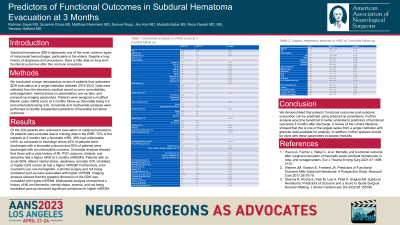Predictors of Functional Outcomes in Subdural Hematoma Evacuation at 3 months
Predictors of Functional Outcomes in Subdural Hematoma Evacuation at 3 Months
Friday, April 21, 2023


Rahman Sayed, BS
Medical Student
Albert Einstein College of Medicine
Morris Plains, New Jersey, United States
ePoster Presenter(s)
Introduction: Subdural hematoma (SDH) represents one of the most common types of intracranial hemorrhages. Despite a long history of diagnoses and procedures, there is little data on long-term functional outcomes after this common procedure.
Methods: We conducted a large retrospective review of patients that underwent SDH evacuation at a single institution between 2015-2022. Data were collected from the electronic medical record on prior comorbidities, anticoagulation, mental status on presentation, pre-op labs, and pre/post-op imaging parameters. Patients were assigned a modified Rankin scale (mRS) score at 3 months follow-up (favorable being 0-2 and unfavorable being 3-6). Univariate and multivariate analyses were carried out.
Results: Of the 329 patients who underwent evacuation of subdural hematoma, 59 patients were excluded due to missing data in the EMR. 72% of the patients at 3 months had a favorable mRS, 28% had unfavorable mRS, as compared to discharge where 40% of patients were discharged with a favorable outcome and 60% of patients were discharged with an unfavorable outcome. Univariate analysis showed that those with a prior history of MI, PVD, seizures, dialysis, and dementia had a higher mRS at 3 months (mRS3M). Patients with an acute SDH, altered mental status, weakness, pronator drift, intubated, or higher GCS scores all had a higher mRS3M. Furthermore, prior coumadin use, low hemoglobin, a shorter surgery and not being extubated post-op were associated with higher mRS3M. Imaging analysis showed that the greatest dimension of the SDH was correlated with higher mRS3M. Multivariate analysis showed that a history of MI and dementia, mental status, anemia, and not being extubated post-op remained significant predictors for higher mRS3M.
Conclusion : We demonstrated that there is a significant overall improvement in the functional status at 3-months follow-up as compared to discharge. We also identified potential predictors of favorable outcomes. Further analysis would be beneficial to understand these predictors.
Methods: We conducted a large retrospective review of patients that underwent SDH evacuation at a single institution between 2015-2022. Data were collected from the electronic medical record on prior comorbidities, anticoagulation, mental status on presentation, pre-op labs, and pre/post-op imaging parameters. Patients were assigned a modified Rankin scale (mRS) score at 3 months follow-up (favorable being 0-2 and unfavorable being 3-6). Univariate and multivariate analyses were carried out.
Results: Of the 329 patients who underwent evacuation of subdural hematoma, 59 patients were excluded due to missing data in the EMR. 72% of the patients at 3 months had a favorable mRS, 28% had unfavorable mRS, as compared to discharge where 40% of patients were discharged with a favorable outcome and 60% of patients were discharged with an unfavorable outcome. Univariate analysis showed that those with a prior history of MI, PVD, seizures, dialysis, and dementia had a higher mRS at 3 months (mRS3M). Patients with an acute SDH, altered mental status, weakness, pronator drift, intubated, or higher GCS scores all had a higher mRS3M. Furthermore, prior coumadin use, low hemoglobin, a shorter surgery and not being extubated post-op were associated with higher mRS3M. Imaging analysis showed that the greatest dimension of the SDH was correlated with higher mRS3M. Multivariate analysis showed that a history of MI and dementia, mental status, anemia, and not being extubated post-op remained significant predictors for higher mRS3M.
Conclusion : We demonstrated that there is a significant overall improvement in the functional status at 3-months follow-up as compared to discharge. We also identified potential predictors of favorable outcomes. Further analysis would be beneficial to understand these predictors.
